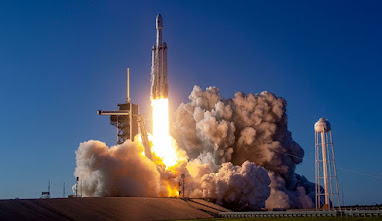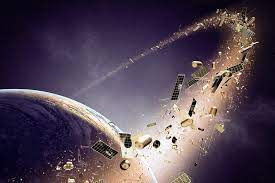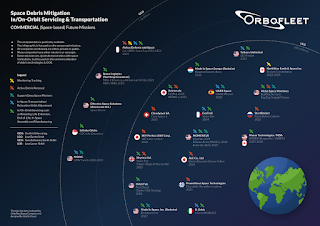Space Debries
Space Debries
Space Debris, also known as Space Junk or Space Pollution, is
man-made debris found in space, outside the earth's atmosphere. These objects
in orbit around the Earth have no use value and pose a threat to space travel.
It can range from paint flakes or metal particles, to no longer needed
satellite instrument lids, bolts or springs, to a complete discarded artificial
moon or rocket stage . Space Debris or space junk is the residue
of human activity in space, left in Earth's orbit since the beginning of space
travel in the late 1950s. The very first man-made space debris thus comes from
the protective casing of the Soviet satellite Sputnik and the coupling device
of its launch vehicle. Space debris consists mainly of space engineering waste,
spent rocket stages, old satellites, debris and fragments from crashes and
explosions, but also dropped screws, nuts and paint chips .
While there are about 2,000 active
satellites orbiting Earth at the moment, there are also 3,000 dead ones
littering space. What's more, there are around 34,000 pieces of space junk
bigger than 10 centimetres in size and millions of smaller pieces that could
nonetheless prove disastrous if they hit something else . More than 27,000 pieces of orbital
debris, or “space junk,” are tracked by the Department of Defense’s global
Space Surveillance Network (SSN) sensors. Much more debris -- too small to be
tracked, but large enough to threaten human spaceflight and robotic missions --
exists in the near-Earth space environment. Since both the debris and
spacecraft are traveling at extremely high speeds (approximately 15,700 mph in
low Earth orbit), an impact of even a tiny piece of orbital debris with a
spacecraft could create big problems .
There are approximately 23,000 pieces of debris larger than a softball
orbiting the Earth. They travel at speeds up to 17,500 mph, fast enough for a
relatively small piece of orbital debris to damage a satellite or a spacecraft.
There are half a million pieces of debris the size of a marble or larger (up to
0.4 inches, or 1 centimeter) or larger, and approximately 100 million
pieces of debris about .04 inches (or one millimeter) and larger. There is even
more smaller micrometer-sized (0.000039 of an inch in diameter) debris .
On July 24, 1996, in the first collision between an
operational satellite and a piece of space debris, a fragment from the upper
stage of a European Ariane rocket collided
with Cerise, a French microsatellite. Cerise was damaged but continued to
function. The first collision that destroyed an operational satellite happened
on February 10, 2009, when Iridium 33, a communications satellite owned by the American
company Motorola, collided with Cosmos 2251, an inactive Russian
military communications satellite, about 760 km (470 miles) above northern
Siberia, shattering both satellites .
The worst space-debris event happened on January 11, 2007,
when the Chinese military destroyed the Fengyun-1C weather satellite in a test of an
anti-satellite system, creating more than 3,000 fragments, or more than 20
percent of all space debris. Within two years those fragments had spread out
from Fengyun-1C’s original orbit to form a cloud of debris that completely
encircled Earth and that would not reenter the atmosphere for decades. On
January 22, 2013, the Russian laser-ranging satellite BLITS (Ball Lens in
the Space) experienced a sudden change in its orbit and its spin, which caused
scientists to abandon the mission. The culprit was believed to have been a
collision with a piece of Fengyun-1C debris. Fragments from Fengyun-1C, Iridium
33, and Cosmos 2251 account for about one-half of all debris below 1,000 km
(620 miles) .
As space debris orbits
around the earth at tremendous speeds - about 15,700 miles per hour (25,265
kph) in low Earth orbit - it could cause significant damage to a satellite or a
spacecraft in case of a collision .
2,000 active satellites in Earth's orbit
3,000 dead satellites in
Earth's orbit
34,000 pieces of space
junk larger than 10 centimetres
128 million pieces of
space junk larger than 1 millimetre
One in 10,000: risk of
collision that will require debris avoidance manoeuvres
25 debris avoidance
manoeuvres by the ISS since 1999 .
This is an idea proposed by NASA
scientist Donald Kessler in 1978. He said that if there was too much space junk
in orbit, it could result in a chain reaction where more and more objects
collide and create new space junk in the process, to the point where Earth's
orbit became unusable .
Japan's Aerospace Exploration Agency (JAXA) and the
European Space Agency have partnered with start-ups to help with removal of
space debris . While JAXA has launched a six-month demonstration project
with Astroscale for the world's first
debris removal mission, ESA is working with Swiss start-up ClearSpace for launching a
mission in 2025.
Project NETRA is an initiative by the
Indian Space Research Organisation (ISRO) which is an early warning system in
space to detect debris and hazards to the Indian satellite . Under this
project, the Indian space organisation plans to put up many observational
facilities like telescopes, connected radars, data processing units, and a
control center.
With best wishes from
Suvendu Singha(India, Odisha, Balasore ,
Jaleswer)
Please reply friends














Sir I love to read your blogs.your writing encourage me for everything.
ReplyDelete